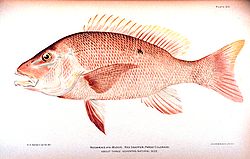Tag Archives: Florida Panhandle
Despite Oil Spill, Fish Fry Showing up In Record Numbers in Gulf of Mexico
Snapper fry are all over the place. There are also trout, grunt and grouper fry all over the place as well. The early tabulation of the annual count in the beds of grass spattered about the northern part of the Gulf of Mexico seems to suggest that the larvae of some kinds of fish have survived the BP oil fiasco, and what’s more, there are swarms of them.
“My preliminary assessment, it looks good, it looks like we dodged a bullet. In terms of the numbers of baby snapper and other species present in the grass beds, things look right,” commented a scientist with the University of North Carolina’s Institute of Marine Science, Joel Fodrie, who has been actively involved in the study of seagrass meadows along the coast for the past five years.
Joel’s group has taken samples of the different sea life in the grass beds in Alabama, Mississippi, and the Florida Panhandle. They will be taking a sample from around Louisiana’s Chandeleur Islands come this Autumn.
Back at the height of the fiasco, when a seemingly endless stream of oil was floating about on the surface, researchers were most concerned as to whether the trillions of larvae which hatch each spring offshore would survive the severe contamination of the spill.
It’s looking like they did, and it’s a good thing too. It just goes to show you that mother nature is more resilient than we give her credit for. There is hope yet for the Gulf to make a full recovery, and that folks, is good news indeed.
Whale sharks sightings on the increase in the Gulf of Mexico
Scientists say they are baffled by the large number of whale shark sightings reported this summer in the northern Gulf of Mexico. Reports have been pouring in from all over; from Clearwater to the Florida Panhandle and along the Alabama, Mississippi and Louisiana coasts.
“The sheer number of anecdotal reports from the public is amazing. There’s obviously something going on,” says shark scientist Bob Hueter who heads the Shark Research Center at Mote Marine Laboratory.
It is common for Whale sharks to gather in the plankton-rich waters off the Yucatan Peninsula during the summer, but this year numerous whale shark sightings have been reported from the eastern and northern parts of the Gulf as well. The concentrations spotted off the Yucatan Peninsula are also higher than before with hundreds of Whale sharks being seen in a single location.
According to Mote Marine Laboratory records, there were just three Whale shark sightings in the Florida Gulf in 2005, two in 2006, five in 2007, and three in 2008. This year, there have been 12 sightings just from July to mid-August.
According to Heuter, the large Whale sharks may have been attracted by a change in the massive “loop current” in the Gulf that took place this year, and there is also a stronger than usual upwelling of cold, nutrient-rich water off the Yucatan that may play a role.
“That changed the oceanography a bit, and it could have driven some of these animals up into the northern Gulf,” Hueter explained.
Eric Hoffmayer, a biologist with the Gulf Coast Research Laboratory on the Mississippi coast, said his lab has gotten reports of 30 sightings in just the last two weeks. On Aug. 1, there was a reported sighting of more than 100 whale sharks congregating about 60 miles off the Louisiana coast.
“We don’t know what’s going on,” said a baffled Hoffmayer.
Many of the sightings have occurred when there was a full moon.
As mentioned above, record sightings are being reported from the waters off Yucatan as well. An aerial survey last week did for instance reveal over 400 whale sharks in a relatively small area near the Isla Mujeres. The Yucatan aggregation is an annual phenomenon, but it usually takes place near Isla Holbox and the group tends to be much smaller.
